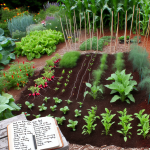Understanding Crop Rotation
Crop rotation is one of the most effective techniques for maintaining soil health and increasing vegetable yield. By changing the types of crops grown in specific areas of your garden each season, you can prevent soil depletion, reduce pest infestations, and enhance nutrient availability.
Why Crop Rotation Matters
Using the same plot for growing a single type of crop continuously can lead to soil nutrient depletion. Different plants absorb different nutrients; therefore, rotating crops ensures balanced nutrient uptake. It also helps in breaking pest and disease cycles, since many pests and fungi are host-specific and will not survive without their preferred plants.
The Basics of Crop Rotation
When planning your crop rotation, consider the following categories of plants:
1. **Leafy Greens**: Lettuce, spinach, kale
2. **Root Vegetables**: Carrots, radishes, beets
3. **Fruit-bearing Plants**: Tomatoes, cucumbers, peppers
4. **Legumes**: Peas, beans
Rotating these categories systematically can help in maintaining soil health.
Example of a Four-Year Crop Rotation Plan
- Year 1: Plant leafy greens in plot A, root vegetables in plot B, fruit-bearing plants in plot C, and legumes in plot D.
- Year 2: Move leafy greens to plot B, root vegetables to plot C, fruit-bearing plants to plot D, and legumes to plot A.
- Year 3: Shift leafy greens to plot C, root vegetables to plot D, fruit-bearing plants to plot A, and legumes to plot B.
- Year 4: Rotate leafy greens to plot D, root vegetables to plot A, fruit-bearing plants to plot B, and legumes to plot C.
Enhancing Soil Fertility
Legumes play a crucial role in enriching the soil. They possess nitrogen-fixing bacteria in their root nodules, which convert atmospheric nitrogen into a form that plants can absorb. After growing legumes in a plot, the nitrogen levels in the soil will be significantly higher, making it an excellent location for nitrogen-intensive crops the following year.
Pest and Disease Management
Rotating crops makes it difficult for pests and diseases to establish themselves. For instance, nematodes that attack tomatoes will not thrive if beans are planted in the same spot the following year. This method significantly reduces the necessity for chemical pesticides.
Improving Soil Structure
Different crops have distinct root structures that interact with the soil in various ways. Root vegetables, for instance, help to break up compacted soil, creating better drainage and aeration. Leafy greens, generally shallow-rooted, do not stress the soil structure but contribute organic matter which enhances soil fertility when decomposed.
Practical Tips for Effective Crop Rotation
– **Record Keeping**: Maintain detailed records of your plantings to prevent repeating the same crop in the same plot within a short period.
– **Cover Crops**: Use cover crops like clover or rye in the off-season to add organic matter to the soil and suppress weeds.
– **Companion Planting**: Combine crop rotation with companion planting to maximize benefits; for example, grow basil alongside tomatoes to deter pests.
Conclusion
Implementing a thoughtful crop rotation strategy can seem complex at first, but the benefits are manifold. From boosted soil fertility to effective pest and disease control, crop rotation is a time-tested method every gardener can incorporate into their practices. Keep meticulous records, observe your plants’ interactions, and adjust your rotation plan as needed to achieve a thriving, sustainable garden.



GIPHY App Key not set. Please check settings